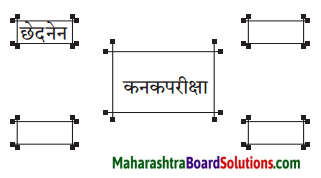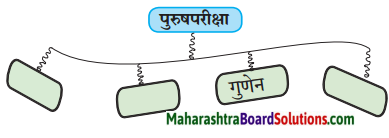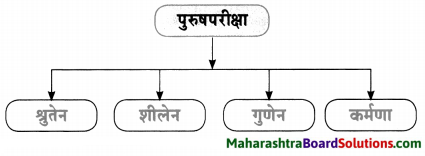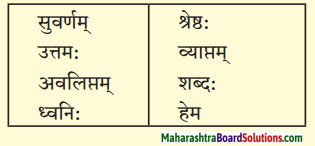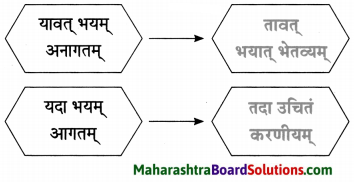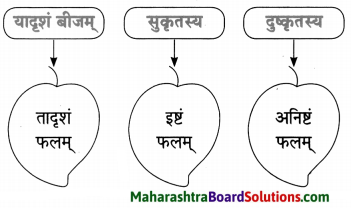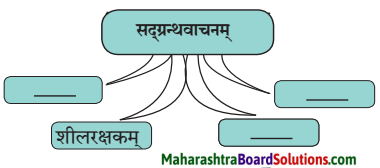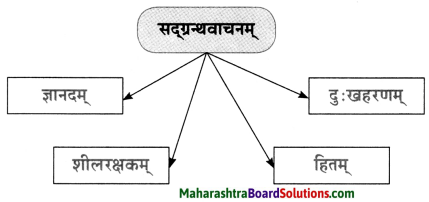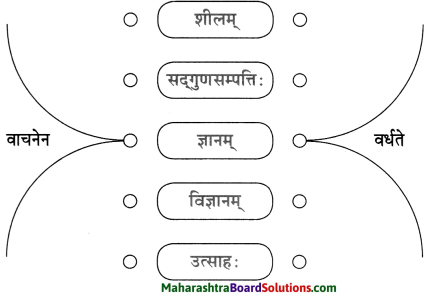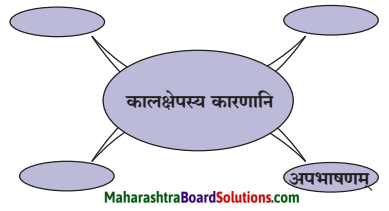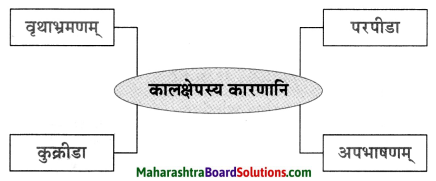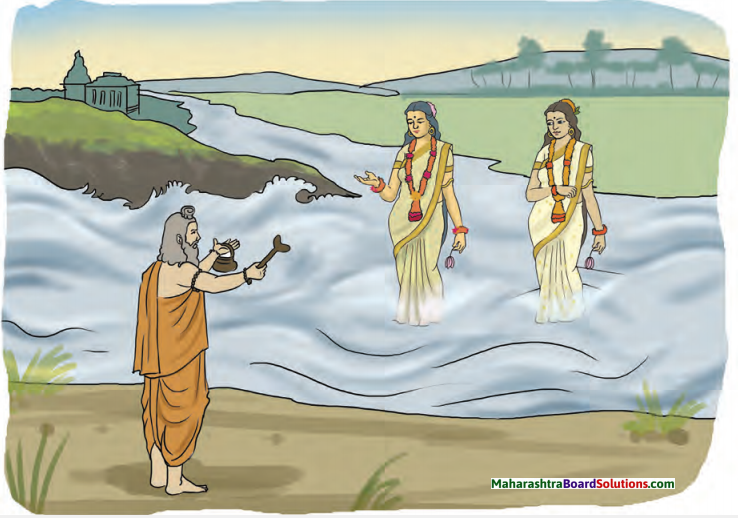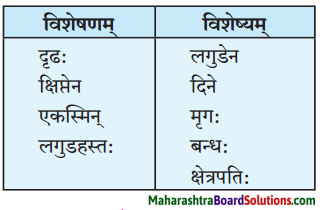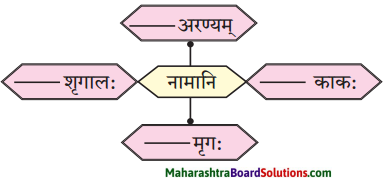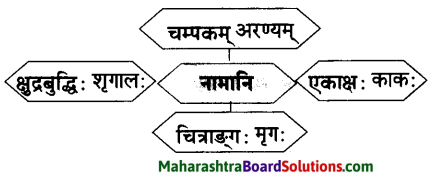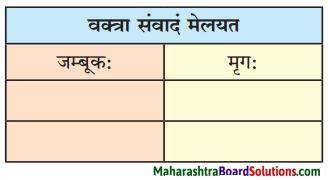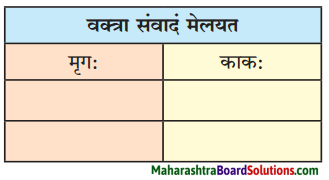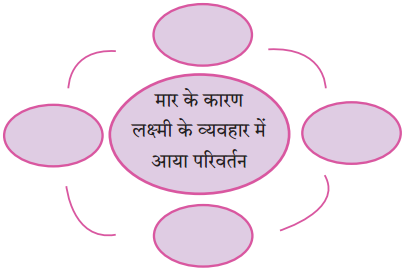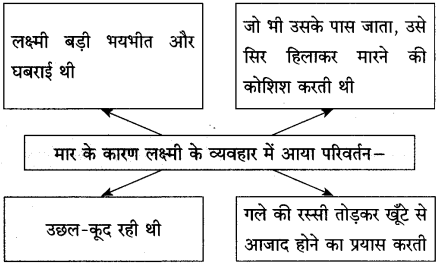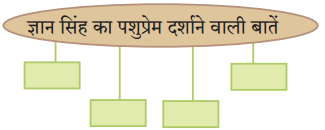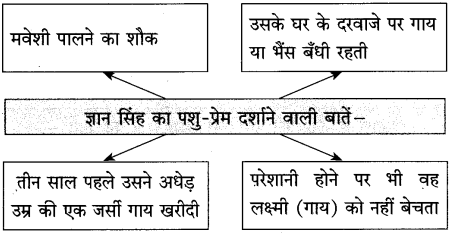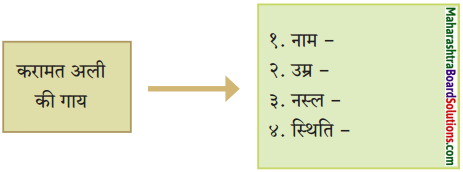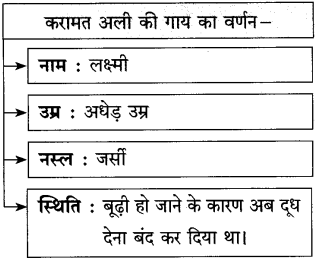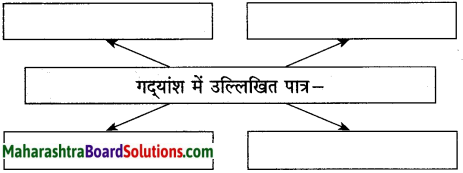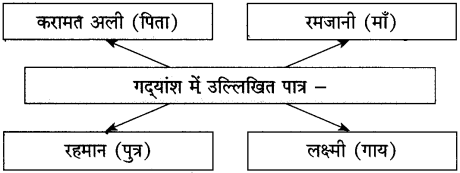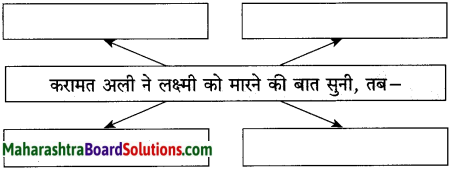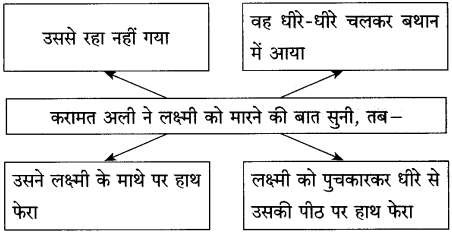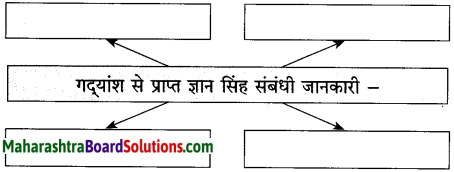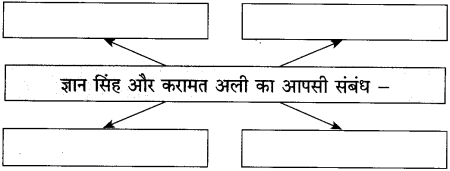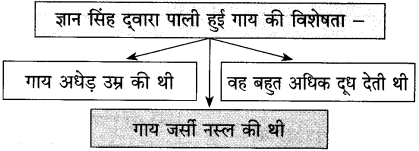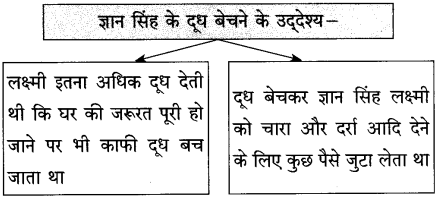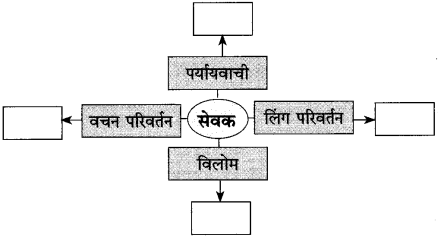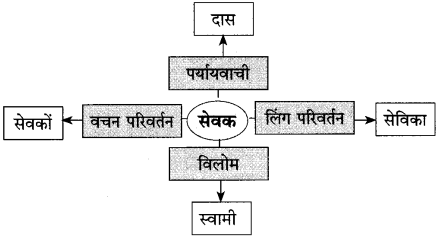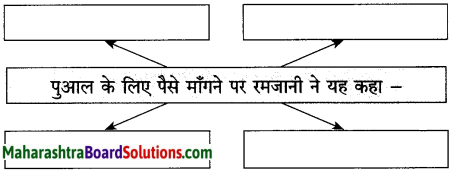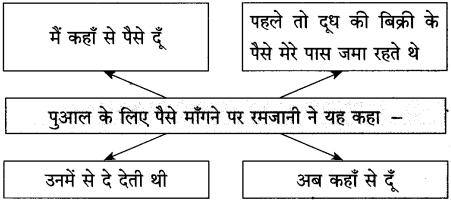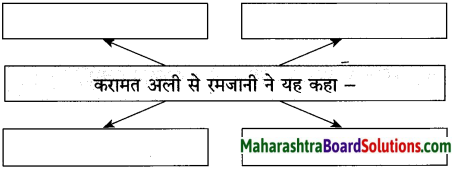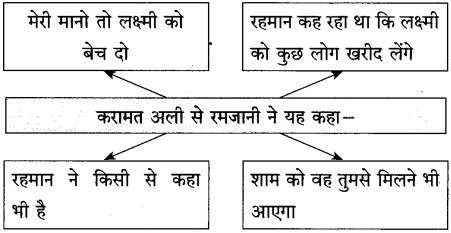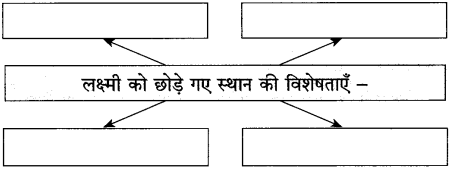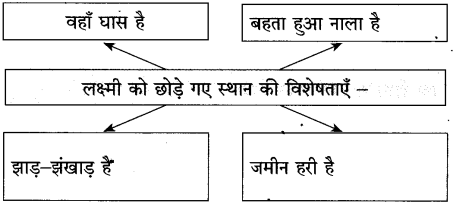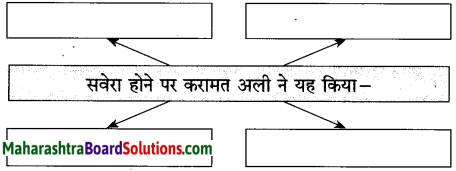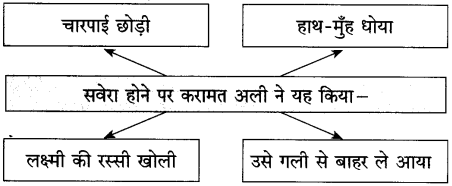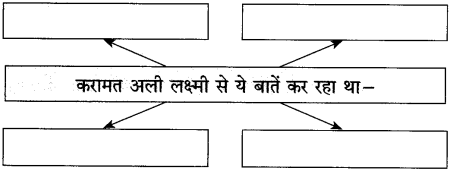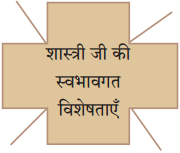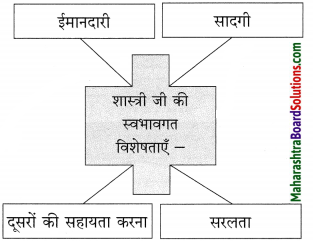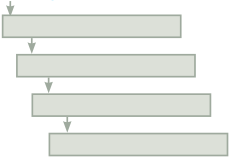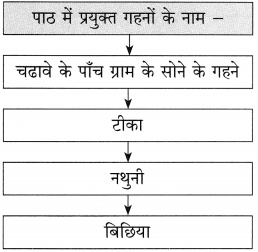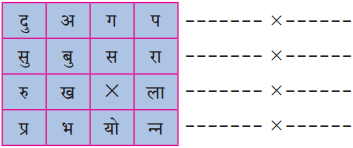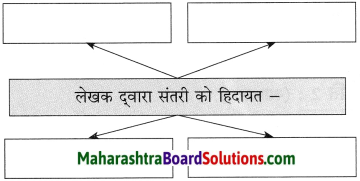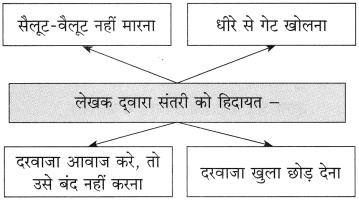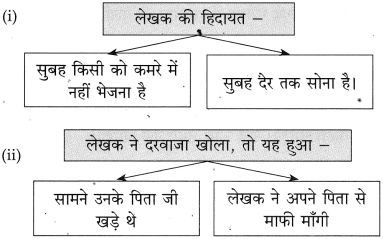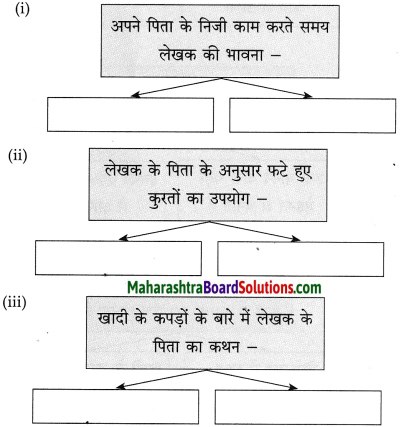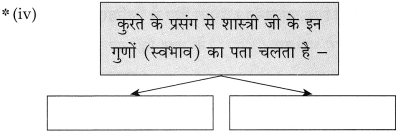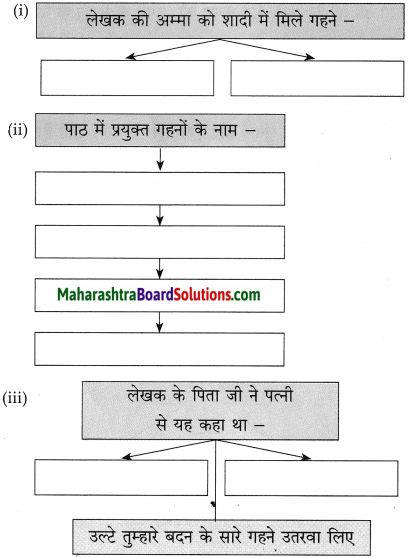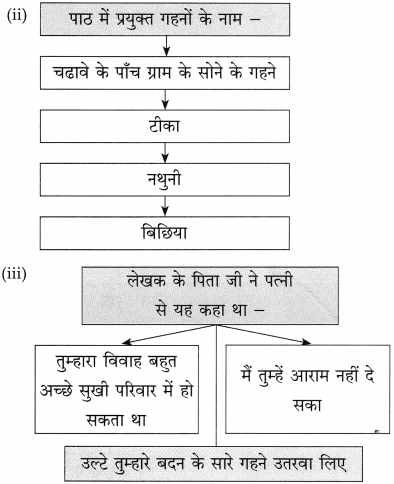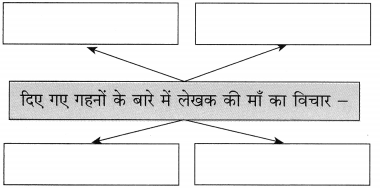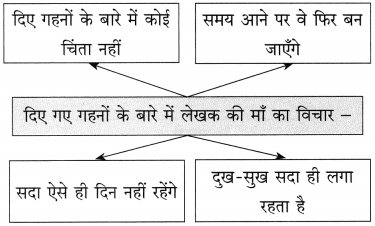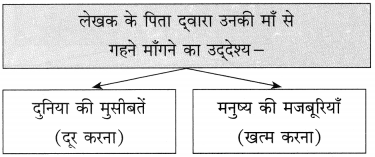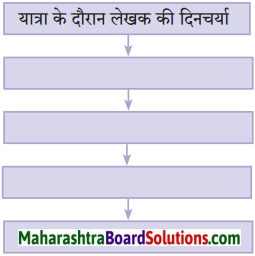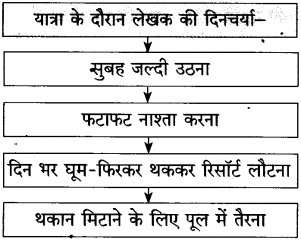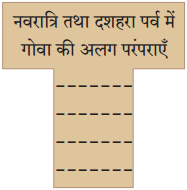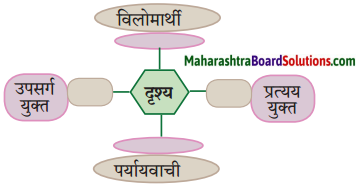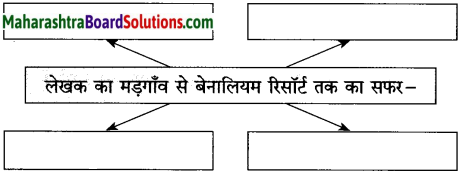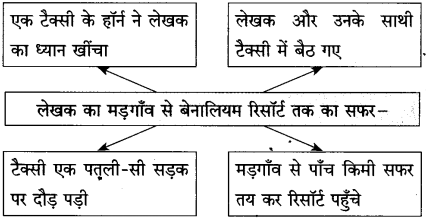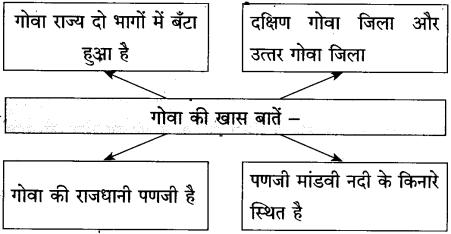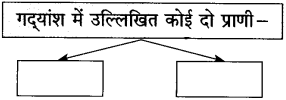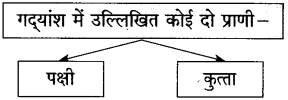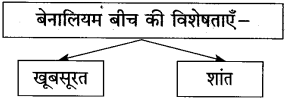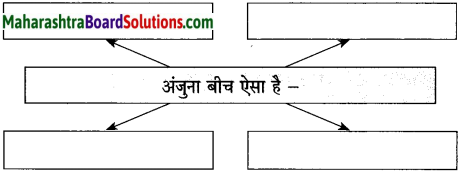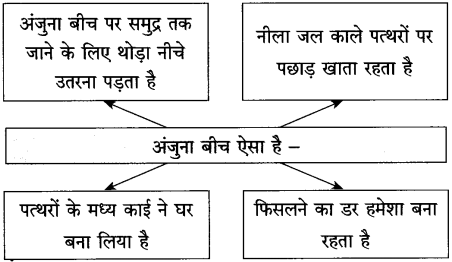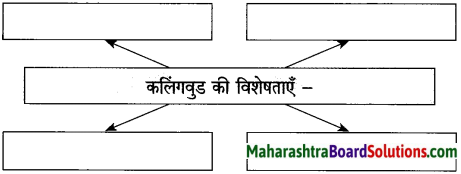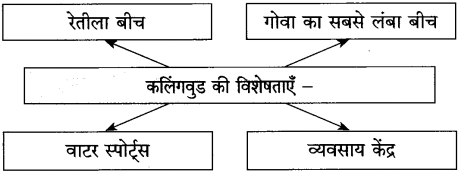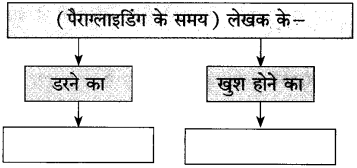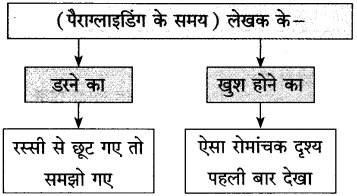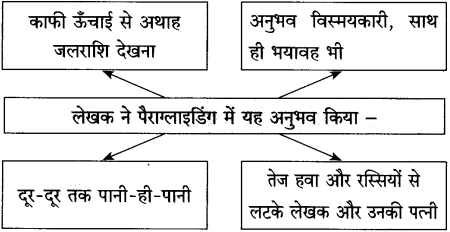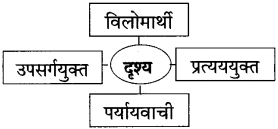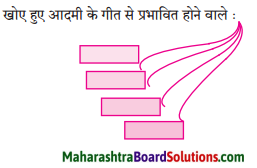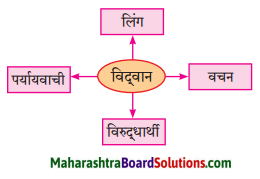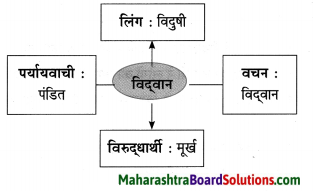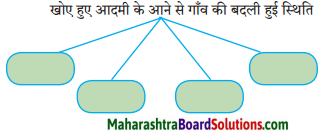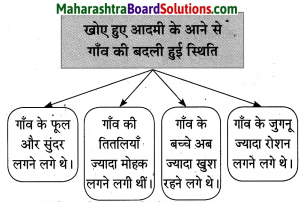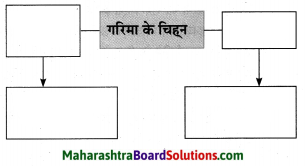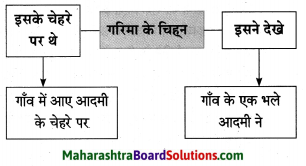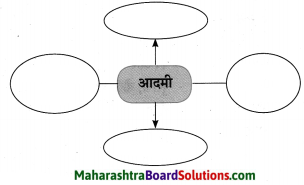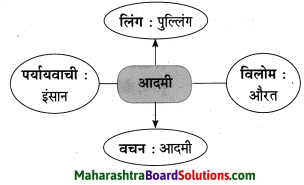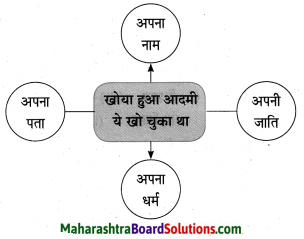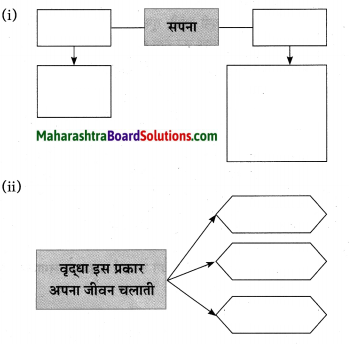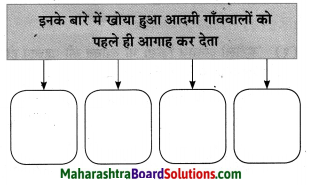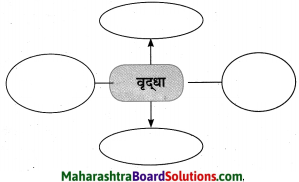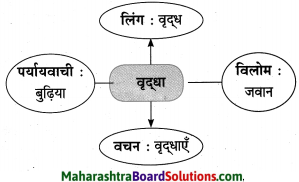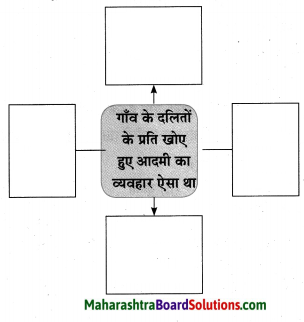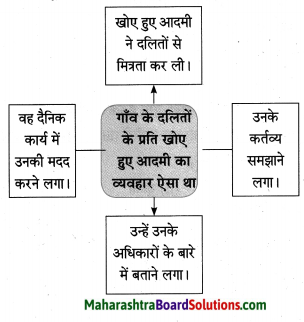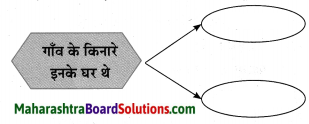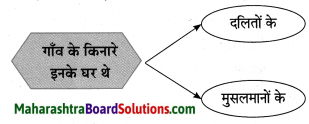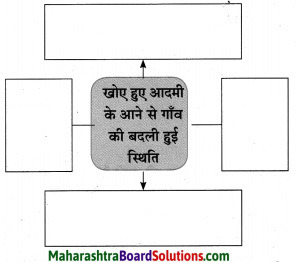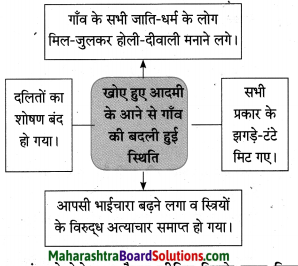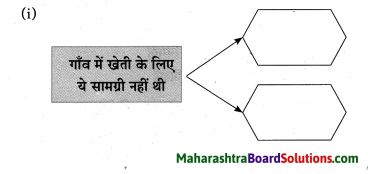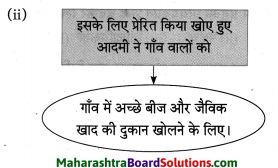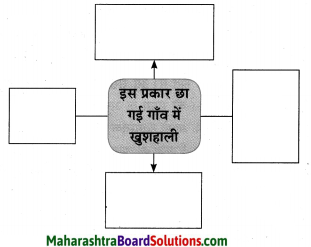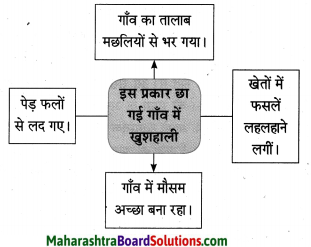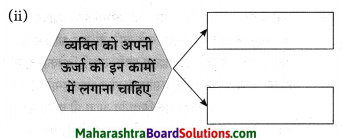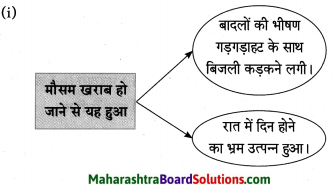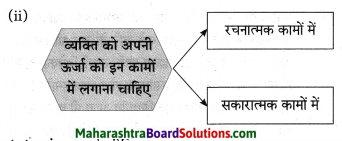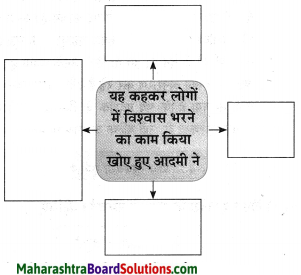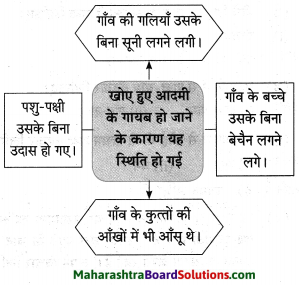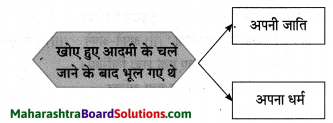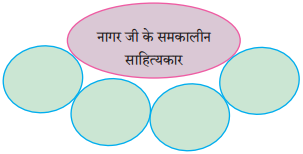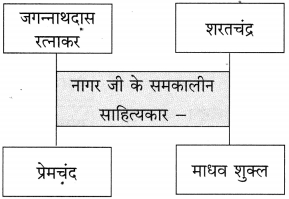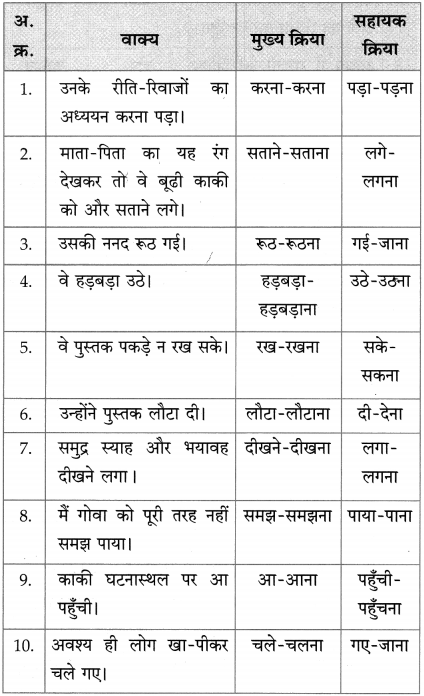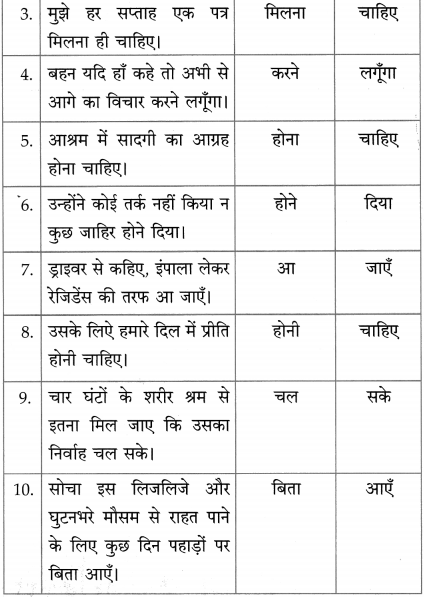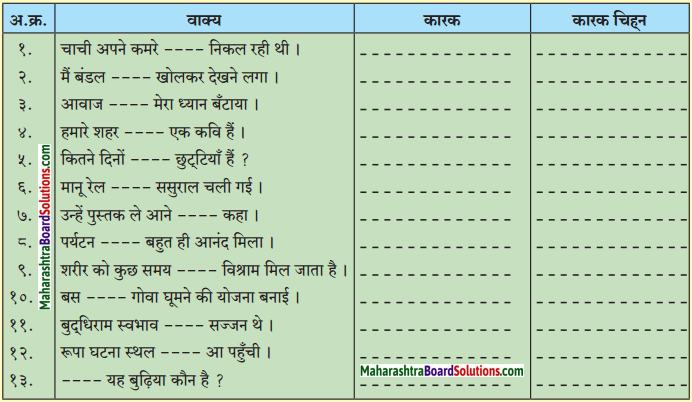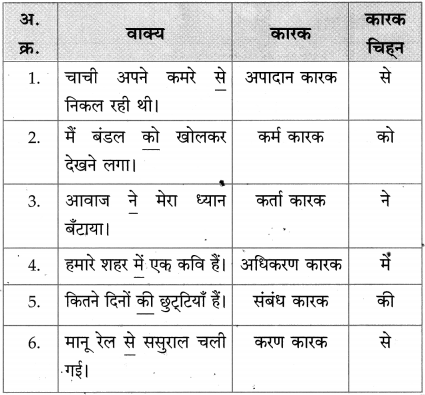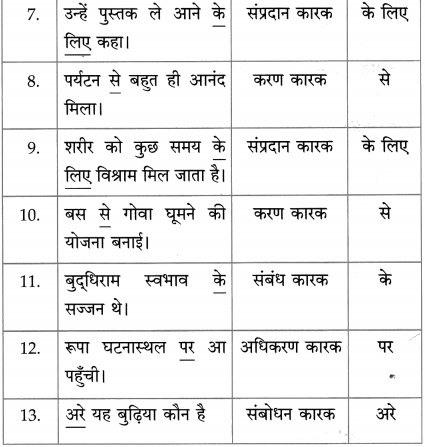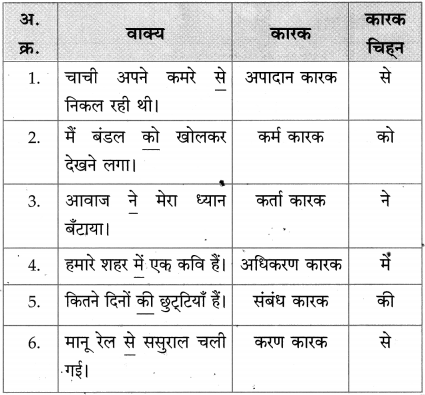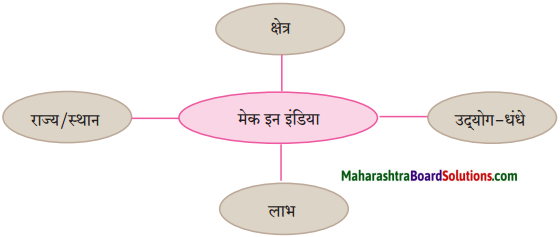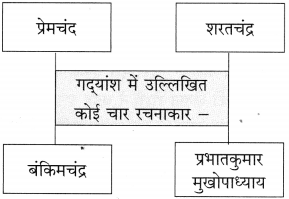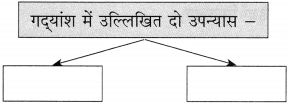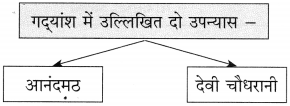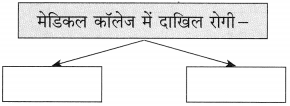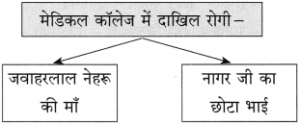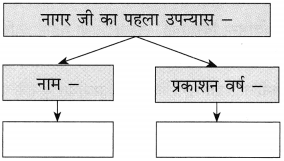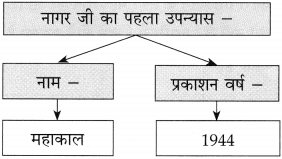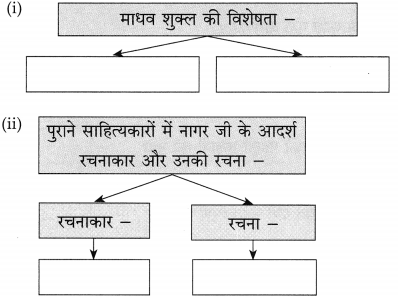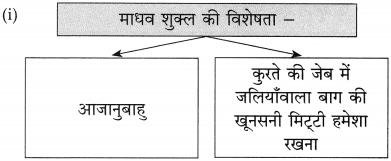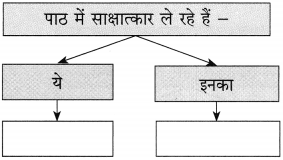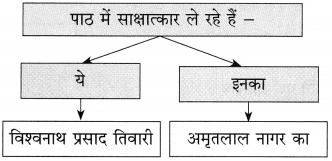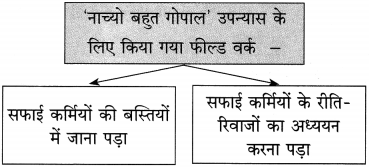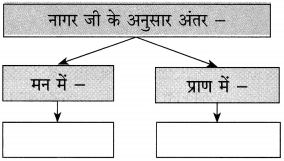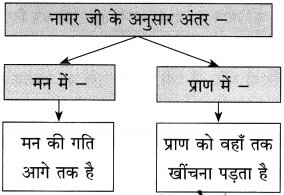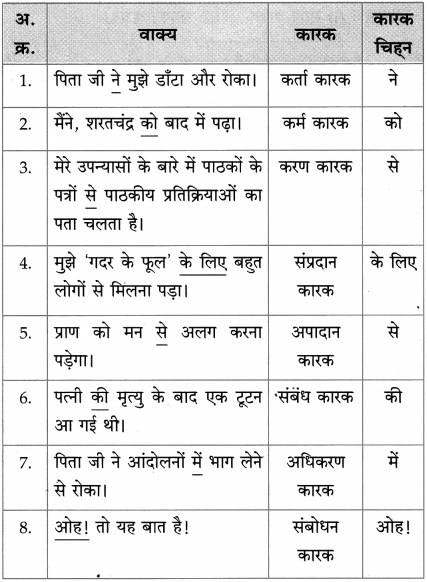Class 10th Sanskrit Anand Chapter 4 स एव परमाणुः Question Answer Maharashtra Board
Balbharti Maharashtra State Board Class 10 Sanskrit Solutions Anand Chapter 4 स एव परमाणुः Notes, Textbook Exercise Important Questions and Answers.
Std 10 Sanskrit Chapter 4 Question Answer
Sanskrit Anand Std 10 Digest Chapter 4 स एव परमाणुः Textbook Questions and Answers
भाषाभ्यास:
1. पूर्णवाक्येन उत्तरं लिखत ।
प्रश्न अ.
अर्णवः पाकगृहात् किम् आनयति?
उत्तरम् :
अर्णवः पाकगृहात् मुष्टिमात्रान् तण्डुलान् आनयति।
प्रश्न आ.
कः परमाणुः?
उत्तरम् :
द्रव्यस्य अन्तिम : घटक : मूलं तत्त्वं च परमाणुः ।
प्रश्न इ.
परमाणुसिद्धान्तः केन महर्षिणा कथितः?
उत्तरम् :
परमाणुसिद्धान्त: कणादमहर्षिणा कथितः ।
![]()
प्रश्न ई.
महर्षिणा कणादेन परमाणुविषये किं प्रतिपादितम् ?
उत्तरम् :
महर्षिणा कणादेन परमाणुविषये प्रतिपादितं यत् परमाणुः अतीन्द्रियः, सूक्ष्मः, निरवयवः, नित्यः, स्वयं व्यावर्तकः च ।
प्रश्न उ.
महर्षेः कणादस्य मतानुसारं परमाणोः व्याख्या का?
उत्तरम् :
जालसूर्यमरीचिस्थं यत् सूक्ष्म रजः दृश्यते तस्य षष्ठतमः भाग: स: परमाणु: उच्यते इति परमाणो: व्याख्या महर्षे: कपादस्य।
2. समानार्थकशब्दान् लिखत ।
कुसुमम्, विश्वम्, पिता, नामधेयम्, सूर्यः ।
प्रश्न 1.
समानार्थकशब्दान् लिखत ।
कुसुमम्, विश्वम्, पिता, नामधेयम्, सूर्यः ।
![]()
3. माध्यमभाषया उत्तरं लिखत ।
प्रश्न अ.
महर्षिः कणादः परमाणुविषये किं प्रतिपादितवान् ?
उत्तरम् :
भारतीय ऋषि व तत्वज्ञ कणाद यांनी परमाणूचा सिद्धांत मांडला. त्यानुसार, परमाणू हा द्रव्याचा अंतिम घटक आहे. व त्यामागील मूलतत्त्व आहे. परमाणू हे द्रव्याचे मूळ कारण आहे. परमाणूच्या स्वरूपाविषयी सांगताना कणाद पुढील स्पष्टीकरण देतात – परमाणू हा इंद्रियांना अगोचर, अतिशय सूक्ष्म, अवयवहीन, नित्य व स्वत:भोवती भ्रमणशील असा आहे.
थोडक्यात, कणाद ऋषी परमाणूचा सिद्धांत स्पष्ट करतात व विश्वाचे अस्तित्व टिकवून ठेवणाऱ्या प्रत्येक द्रव्यामागे ‘परमाणू हेच कारण असल्याचे मानतात.
The theory of atoms was formulated by an Indian sage and philosopher कणाद, Sage कणाद considered the last element of a substance and the basic principle as परमाणु, an atom. परमाणु is the chief cause of the substance. Sage कणाद further explained that परमाणु is inaccessible to the senses, very small (microscopic), formless, eternal and self-revolving.
In brief, sage कणाद believed in the theory of परमाणु and accepted it to be the cause of each substance, because of which the world exists.
![]()
प्रश्न आ.
‘तण्डुलान् आनय’ इति पिता अर्णवं किमर्थम् आदिष्टवान् ?
उत्तरम् :
स एव परमाणु:’ या पाठातील अर्णव व त्याच्या वडिलांच्या संभाषणाद्वारे परमाणूची संकल्पना स्पष्ट होते. एकदा अर्णव त्याच्या बागेतून जास्वंदाचे फूल आणतो. फुलातील परागकण बघत असताना अर्णवचे वडील त्याला सूक्ष्मदर्शिकेमधून ते कण पाहण्याचा सल्ला देतात. परागकणांतील इतर घटकही सूक्ष्मदर्शिकेतून सहज दिसल्यावर अर्णवला आश्चर्य वाटते.
तेव्हा त्याचे वडील ‘स एव त्याला विचारतात की ज्याप्रमाणे आपण सूक्ष्मदर्शिकतून परागकण पाहू शकतो, तसेच परमाणू सुद्धा पाहता येतो का? यानंतर अर्णव त्याच्या वडिलांना परमाणूबद्दल विचारतो. त्याच्या शंकेचे निरसन करण्यासाठी अर्णवचे वडील त्याला मूठभर तांदूळ आणावयास सांगतात.
त्यातील एक तांदळाचा दाणा जितका विभागला जाऊ शकतो, तितके त्याचे विभाजन करण्यास सांगतात. पुढे ‘परमाणू’ बद्दल स्पष्टीकरण देताना ते सांगतात की तांदूळ एका मर्यादपर्यंतच तोडला जाऊ शकतो, त्या विभाजनानंतर जो सूक्ष्म कण राहतो, तो म्हणजे परमाणू. अशा प्रकारे, तांदळाच्या उदाहरणाद्वारे अर्णवचे वडील त्याला परमाणूबद्दल योग्य ते ज्ञान देतात.
‘स एव परमाणुः’ reveals the philosophy behind the concept of परमाणु through the conversation between अर्णव and his father.
Once अर्णव brought a hibiscus-flower from his garden. He was observing its pollengrains, then his father advised him to observe it through microscope. was amazed to see the pollen-grain with its elements. After a while, father asked him, can we see परमाणू like pollen-grains through microscope? अर्णव questioned his father about 40. To answer his question, aura’s father instructed him to bring handful of rice-grains.
Later, father told अर्णव to break it till its last part. Father explained that just as rice. grains will be powdered if divided further likewise an atom is that part of the substance which can’t be obtained by division In this way, with the help of rice-grains example ama’s father aptly explains the concept of परमाणू.
![]()
4. विरुद्धार्थकशब्दान् मञ्जूषात: अन्विष्य लिखत |
सत्यम्, अन्तिमः, अनित्यः, लघुः, सूक्ष्मः, (आद्यः, गुरुः, नित्यः, असत्यम्, स्थूल:)
प्रश्न 1.
विरुद्धार्थकशब्दान् मञ्जूषात: अन्विष्य लिखत |
सत्यम्, अन्तिमः, अनित्यः, लघुः, सूक्ष्मः, (आद्यः, गुरुः, नित्यः, असत्यम्, स्थूल:)
उत्तरम् :
- सत्यम् × असत्यम्, अनृतम्।
- अन्तिमः × आद्यः।
- अनित्यः × नित्यः।
- लघुः × बृहत्, स्थूलः।
- सूक्ष्मः × स्थूलः।
5. उचितं पर्यायं चित्वा वाक्यं पुनर्लिखत ।
प्रश्न 1.
अ. एतद् विश्वं ………… निर्मितम् । (तण्डुलै:/अणुभिः)
आ. …………… द्रव्यस्य मूलकारणम् । (परमाणुः/विज्ञानं) ।
इ. रजसः ……….. भागः परमाणुः । (षष्ठतमः/शततमः)
उत्तरम् :
अ. अणुभिः
आ. परमाणुः
इ. षष्ठतम
![]()
6. जालरेखाचित्रं पूरयत
प्रश्न 1.
जालरेखाचित्रं पूरयत
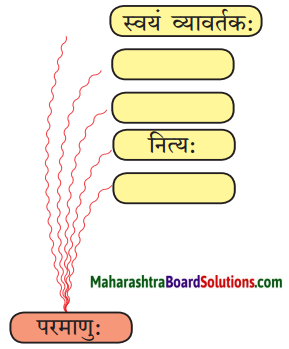
उत्तरम् :

Sanskrit Anand Class 10 Textbook Solutions Chapter 4 स एव परमाणुः Additional Important Questions and Answers
अवबोधनम्
उचितं पर्यायं चित्वा वाक्यं पुनर्लिखत।
प्रश्न 1.
- अर्णवः उद्यानात् ……………. गृहीत्वा प्रविशति। (कमलम् / जपाकुसुमम्)
- जपाकुसुमस्य परागकणाः …………. आसन्। (सूक्ष्माः / स्थूला:)
- सूक्ष्मकणेषु तस्य …………. दृश्यन्ते। (अङ्गानि/गात्राणि)
- अर्णव: मुष्टिमात्रान् तण्डुलान् ……….. आनयति। (उद्यानत: / महानसत:)
- अणुभ्यः …………….. परमाणवः । (सूक्ष्मतराः / स्थूलतराः)
उत्तरम् :
- जपाकुसुमम्
- सूक्ष्मा:
- अगानि
- महानसतः
- सूक्ष्मतरा:
![]()
प्रश्न 2.
पिता अर्णवाय स्वमहाविद्यालयम् आगन्तुं कथयति यतः …..।
(अ) पितु: महाविद्यालये कणादविषयकानि पुस्तकानि सन्ति।
(ब) पितुः महाविद्यालये स्नेह – सम्मेलनम् अस्ति।
उत्तरम् :
पितुः महाविद्यालये कणादविषयकानि पुस्तकानि सन्ति।
कः कं वदति?
प्रश्न 1.
1. अस्माकम् उद्यानात् जपाकुसुमम् आनीतम् मया।
2. किं दृष्टं त्वया?
उत्तरम् :
1. अर्णवः पितरं वदति।
2. पिता अर्णवं वदति।
प्रश्न 2.
मुष्टिमात्रान् तण्डुलान् महानसतः आनय।
उत्तरम् :
पिता अर्णवं वदति।
![]()
प्रश्न 3.
कियान् लघुः अस्ति एषः।
उत्तरम् :
अर्णव : पितरं वदति।
प्रश्न 4.
अयं खलु कणादमहर्षेः सिद्धान्तः।
उत्तरम् :
पिता अर्णवं वदति।
प्रश्न 5.
वयं तु केवलं महाभागस्य नामधेयम् एव जानीमः।
उत्तरम् :
अर्णवः पितरं वदति।
पूर्णवाक्येन उत्तरत।
प्रश्न 1.
सूक्ष्मेक्षिका कुत्र वर्तते?
उत्तरम् :
अर्णवस्य पितु: पार्श्वे उत्पीठिकायां सूक्ष्मेक्षिका वर्तते।
![]()
प्रश्न 2.
अर्णवेन कुत: जपाकुसुमम् आनीतम्?
उत्तरम् :
अर्णवेन तस्य उद्यानात् जपाकुसुमम् आनीतम्।
प्रश्न 3.
विश्व केभ्य: निर्मितम्?
उत्तरम् :
विश्वं परमाणुभ्यः निर्मितम्।
प्रश्न 4.
अणवस्य जिज्ञासा कश्वं शाम्येत्?
उत्तरम् :
कणादविषयकस्य नैकानि पुस्तकानि पठित्वा अर्णवस्य जिज्ञासा शाम्येत्।
![]()
वाक्यं पुनर्लिखित्वा सत्यम् । असत्यम् इति लिखत।
प्रश्न 1.
- एतद् विश्वम् अणुभ्यः निर्मितम्।
- परमाणवः सूक्ष्मेक्षिकया दृश्यन्ते।
- अर्णवस्य पिता चित्रकलायाः प्राध्यापकः।
उत्तरम् :
- सत्यम्।
- असत्यम्।
- असत्यम्।
प्रश्न 2.
1. अर्णवः क्षेत्रात् तण्डुलान् आनयति।
2. अर्णवेन तण्डुलस्य भागत्रयं कृतम्।
उत्तरम् :
1. असत्यम्।
2. असत्यम्।
प्रश्न 3.
एष: गद्यांश: कस्मात् पाठात् उद्धृतः?
उत्तरम् :
एष: गद्यांशः ‘स एव परमाणुः’ इति पाठात् उद्धतः।
![]()
शब्दज्ञानम् :
सन्धिवग्रहः
- उद्यानाद् जपाकुसुमम् – उद्यानात् + जपाकुसुमम्।
- एतद् विश्वम् – एतत् + विश्वम्।
- तदपि – तत् + अपि।
- षष्ठतमो भागः – षष्ठतम : + भागः।
- स उच्यते – सः + उच्यते।
- एतद्विषये – एतत् + विषये।
त्वान्त-ल्यबन्त-तुमन्त-अव्ययानि।
| त्वान्त अव्यय धातु + त्वा / ध्वा / ट्वा / ड्वा / इत्वा /अयित्वा | तुमन्त अव्यय धातु + तुम् / धुम् / टुम् / डुम् / इतुम्/अयितुम् |
| गृहीत्वा, उक्त्वा | द्रष्टुम, कर्तुम्, पठितुम् |
विभक्त्यन्तरूपाणि।.
- तृतीया – मया, त्वया, सूक्ष्मेक्षिकया।
- पज्ञमी – परमाणुभ्यः, उद्यानात्।
- षष्ठी – तस्य, अस्माकम, तेषाम्, विज्ञानस्य, कणानाम्।
- सप्तमी – पुस्तकपठने, उत्पीठिकायाम, सूक्ष्मकणेषु ।
- सम्बोधन – पितः।
विशेषण – विशेष्य – सम्बन्धः।
| विशेषणम् | विशेष्यम् |
| 1. कियन्तः, सूक्ष्माः | परागकणाः |
| 2. मग्नः | पिता |
| 3. मुष्टिमात्रान् | तण्डुलान् |
| 4. लघुतरम् | भागम् |
| 5. सूक्ष्मतराम | भागम् |
| 6. परमः | अणुः |
| 7. अन्तिमः | घटकः |
| 8. मूलम् | तत्वम् |
| 9. पञ्चमे, षष्ठे | शतके |
| 10. महर्षिणा | कणादेन |
| 11. अतीन्द्रियः | परमाणुः |
| 12. सूक्ष्मः | परमाणुः |
| 13. निरवयवः | परमाणुः |
| 14. नित्यः | परमाणुः |
| 15. स्वयं व्यावर्तकः | परमाणुः |
| 16. सूक्ष्मम् | रज: |
| 17. षष्ठतमः | भागः |
| 18. नैकानि | पुस्तकानि |
![]()
लकारं लिखत।
प्रश्न 1.
1. सूक्ष्मेक्षिकया पश्य।
2. तेषां कणानां रचनाम् अपि द्रष्टुं शक्नोषि।
उत्तरम् :
1. लोट्लकारः
2. लट्लकार:
प्रश्न 2.
1. इमं तण्डुलं विभज।
2. यदि क्रियते तर्हि चूर्णं भवेत्।
उत्तरम् :
1. लोट्लकारः
2. विधिलिङ्लकार:
प्रश्न 3.
- कणादविषयकाणि नैकानि पुस्तकानि सन्ति।
- वयं महाभागस्य नामधेयम् एव जानीमः।
- मम महाविद्यालयम् आगच्छ।
उत्तरम् :
- लट्लकारः
- लट्लकारः
- लोट्लकार:
पृथक्करणम् ।
घटकाधारेण शब्दपेटिकां पूरयत।
1.
(सूक्ष्मकणस्य अङ्गानि, परागकणाः, जपाकुसुमम्)
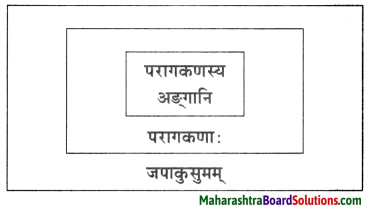
2.
- तथेति – तथा + इति।
- यथाकथमपि – यश्चाकश्चम् + अपि ।
- इतोऽपि – इत: + अपि।
- सम्यग् उक्तम् – सम्यक् + उक्तम्।
- एतद् विभाजनम् – एतत् + विभाजनम्।
![]()
क्रमेण योजयत।
प्रश्न 1.
- अणवस्य सूक्ष्मेक्षिकया निरीक्षणम्।
- पितुः पुस्तकपठनम्।
- सूक्ष्मकणेषु तेषाम् अङ्गानां दर्शनम्।
- अर्णवेन जपाकुसुमस्य चयनम्।
उत्तरम् :
- अर्णवेन जपाकुसुमस्य चयनम्।
- पितुः पुस्तकपठनम्।
- अर्णवस्य सूक्ष्मेक्षिकया निरीक्षणम्।
- सूक्ष्मकणेषु तेषाम् अङ्गानां दर्शनम्।
प्रश्न 2.
- पितुः परमाणुविषयकं स्पष्टीकरणम्।
- अर्णवस्य परमाणुविषये पृच्छा।
- अर्णवेन तण्डुलस्य भागद्वये विभाजनम्।
- मुष्टिमात्रान् तण्डुलान् आनेतुं पितुः आदेशः।
उत्तरम् :
- अर्णवस्य परमाणुविषये पृच्छा।
- मुष्टिमात्रान् तण्डुलान् आनेतुं पितुः आदेशः ।
- अर्णवेन तण्डुलस्य भागद्वये विभाजनम्।
- पितुः परमाणुविषयकं स्पष्टीकरणम्।
![]()
प्रश्न 3.
- पितुः स्वस्य महाविद्यालये निमन्त्रणम्।
- ‘वैशेषिकसूत्राणि’ इति ग्रन्थविषये चर्चा।
- पित्रा कणादमहर्षेः सिद्धान्तविषये कथनम्।
- अर्णवस्य विस्तरेण पठनस्य इच्छा।
उत्तरम् :
- पित्रा कणादमहर्षेः सिद्धान्तविषये कथनम्।
- ‘वैशेषिकसूत्राणि’ इति ग्रन्थविषये चर्चा ।
- अर्णवस्य विस्तरेण पठनस्य इच्छा।
- पितुः स्वस्य महाविद्यालये निमन्त्रणम्।
विभक्त्यन्तरूपाणि।
- तृतीया – मया, त्वया।
- पक्षमी – पाकगृहात, यस्मात्।
- षष्ठी – एतस्य, तस्य।
- तृतीया – तेन, महर्षिणा, मुनिना, निश्चयेन।
- षष्ठी – महर्षेः, द्रव्यस्य, तस्य, महाभागस्य, परमाणोः ।
- सप्तमी – पञ्चमे, षष्ठे, शतके, ग्रन्थे।
विरुद्धार्थकशब्दान् मञ्जूषात: अन्विष्य लिखत |
- अधुना × अनन्तरम्।
- स्मरसि × विस्मरसि।
- बहूनि × अल्पानि।
- समानः × भिन्नः।
![]()
वाक्यं पुनर्लिखित्वा सत्यम् । असत्यम् इति लिखत।
प्रश्न 1.
- द्रव्यस्य आदिम: घटक; परमाणुः अस्ति।
- परमाणो: सिद्धान्तः प्राय: एकोनविंशतितमे शतके महर्षिकणादेन प्रतिपादितः।
- अर्णवस्य पितुः महाविद्यालये कणादविषयकाणि नैकानि पुस्तकानि सन्ति।
उत्तरम् :
- असत्यम्।
- असत्यम्।
- सत्यम्।
![]()
त्वं स्थाने ‘भवान् / भवती’ अथवा ‘भवान् / भवती’ स्थाने ‘त्वं’ योजयत।
प्रश्न 1.
त्वं द्रष्टुं शक्नोषि।
उत्तरम् :
भवान् द्रष्टुं शक्नोति।
प्रश्न 2.
त्वं श्व: मम महाविद्यालयम् आगच्छ।
उत्तरम् :
भवान् श्व: मम महाविद्यालयम् आगच्छतु ।
![]()
प्रश्न 3.
त्वं सूक्ष्मेक्षिकया पश्य।
उत्तरम् :
भवान् सूक्ष्मेक्षिकया पश्यतु ।
प्रश्न 4.
त्वम् इमं तण्डुलं विभज।
उत्तरम् :
भवान् इमं तण्डुल विभजतु ।
प्रश्न 5.
त्वं जानासि किम्?
उत्तरम् :
भवान् जानाति किम्?
वचनं परिवर्तयत।
प्रश्न 1.
ते परमाणवः सूक्ष्मेक्षिकया अपि न दृश्यन्ते। (वाक्यं एकवचने परिवर्तयत।)
उत्तरम् :
सः परमाणुः सूक्ष्मेक्षिकया अपि न दृश्यते ।
![]()
प्रश्न 2.
इमं तण्डुल विभज। (वाक्यं बहुवचने परिवर्तयत।)
उत्तरम् :
इमान्/एनान् तण्डुलान् विभज।
प्रश्न 3.
कियन्तः सूक्ष्माः तस्य परागकणाः । (वाक्यं एकवचने परिवर्तयत।)
उत्तरम् :
कियान् सूक्ष्म: तस्य परागकणः।
प्रश्न 4.
अहम् एतद्विषये विस्तरेण पठितुम् इच्छामि। (वाक्यं बहुवचने परिवर्तयत।)
उत्तरम् :
वयम् एतद्विषये विस्तरेण पठितुम् इच्छामः।
लकारं परिवर्तयत।
प्रश्न 1.
अर्णवः तथा करोति। (वाक्यं लङ्लकारे परिवर्तयत।)
उत्तरम् :
अर्णवः तथा अकरोत्।
![]()
प्रश्न 2.
तव जिज्ञासा निश्चयेन शाम्येत्। (वाक्यं लोट्लकारे परिवर्तयत।)
उत्तरम् :
तव जिज्ञासा निश्चयेन शाम्यतु।
समासाः
| समस्तपदम् | अर्थ: | समासविग्रहः | समासनाम |
| जपाकुसुमम् | a flower named जपा | जपा नाम कुसुमम्। | कर्मधारयः समासः। |
| परमाणुः | atom | परम: अणुः। | कर्मधारयः समासः। |
| सूक्ष्मकणा: | small particles | सूक्ष्माः कणाः। | कर्मधारयः समास:। |
| कणादमुनिः | sage कणाद | कणाद: नाम मुनिः। | कर्मधारयः समासः। |
| महर्षिः | great sage | महान् ऋषिः। | कर्मधारयः समासः। |
| मूलतत्त्वम् | basic principle | मूलं तत्त्वम्। | कर्मधारयः समासः। |
| पुस्तकपठनम् | reading of books | पुस्तकस्य पठनम्। | षष्ठी-तत्पुरुष: समासः। |
| परागकणा: | grains of a pollen | परागस्य कणा:। | षष्ठी-तत्पुरुषः समासः। |
| महाभागः | he who has good fortune | महान् भाग: यस्य सः। | बहुव्रीहिः समासः। |
स एव परमाणुः Summary in Marathi and English
प्रस्तावना :
जगाच्या उत्पत्तीबाबत आतापर्यंत अनेक सिद्धांत मांडले गेले आहेत. विश्व हे छोट्या कणांनी बनलेले आहे हा विचार अतिशय प्राचीन आहे. आण्विक सिद्धांताच्या विकासाचे श्रेय जॉन डाल्टन या इंग्रज रसायन व भौतिकशास्त्रज्ञास दिले जाते.
प्राचीन काळात, भारतीय ऋषी व तत्त्वज्ञ, आचार्य कणादांनी अणूचा सिद्धांत मांडला. त्यांच्या अणुविषयक संकल्पना व विश्वाचे स्वरूप याबाबत सखोल माहिती ‘वैशेषिक दर्शन’ या त्यांच्या ग्रंथात दिली आहे ‘स एव परमाणु:’ या पाठामध्ये अर्णवचे वडील सुबोध, सोप्या उदाहरणाने परमाणूची संकल्पना स्पष्ट करतात.
Many propositions regarding world’s evolution have been put forth to date. The world is made of tiny particles is a very ancient insight. John Dalton, an English chemist and physicist is the man credited today with the development of atomic theory.
In the ancient times, theory of atoms was formulated by an Indian sage and philosopher, कणाद. His ideas about the atom and the nature of the universe are written in his trentise ‘वैशेषिक दर्शन’. In the lesson, ‘स एव परमाणु: अर्णव’s father explains the concept of sty (atom) with lucid examples.
![]()
परिच्छेदः 1
अर्णव: जपाकुसुम …………………. न दृश्यन्ते।
अनुवादः
(अर्णव जास्वंदाचे फूल घेऊन प्रवेश करतो. त्याचे वडील विज्ञानाचे प्राध्यापक आहेत. ते पुस्तक वाचण्यात तल्लीन झाले आहेत. त्यांच्या जवळच टेबलावर सूक्ष्मदर्शिका आहे.)
- अर्णव – अहो बाबा, मी आपल्या बागेतून जास्वंदाचे फूल आणले आहे. त्याचे परागकण किती सूक्ष्म आहेत ना!
- वडील – सूक्ष्मदर्शिकने पहा. तू त्याच्या कणांची रचनासुद्धा पाहू शकतोस. (अर्णव तसे करतो)
- वडील – तू काय पाहिलेस?
- अर्णव – बाबा, ते (अद्भुत) विलक्षण आहे. सूक्ष्मकणांमध्ये त्यांचे भाग दिसत आहेत.
- बाबा – अर्णव, फुलाचे हे अंश तू सूक्ष्मदर्शिकेने पाहू शकतोस. पण हे जग अणूंनी निर्माण झाले आहे. ते अणू सूक्ष्मदर्शिकने सुद्धा दिसत नाहीत.
(अर्णव enters taking the hibiscus-flower. His father is a professor of science. He is engrossed in reading a book. Near him, there is a microscope on the table.)
- Arnav: Oh father, I have brought a hibiscus flower from our garden. Its pollen-grains are indeed microscopic!
- Father: Observe it through a microscope. You can see even the structure of its particles. (Arnav does accordingly.)
- Father: What did you see (observe)?
- Arnav: O father, it is amazing. The parts of these minute particles are seen.
- Father: Arnav, you can see the parts of this flower through microscope. But this world is created from atoms. Those atoms are not seen even through the microscope.
![]()
परिच्छेदः 2
अर्णवः परमाणुः ………….. परमः अणुः ।
अनुवादः
- अर्णव – परमाणू म्हणजे काय?
- बाबा – अच्छा, मी सांगतो. स्वयंपाकघरातून मूठभर तांदूळ आण.
- अर्णव – (हो असे म्हणून, तो स्वयंपाकघरातून तांदूळ आणतो) बाबा, है घ्या.
- बाबा – आता या तांदळाचे भाग कर.
- अर्णव – बाबा, किती लहान (तांदूळ) आहे हा. बघा, मी कसेबसे याचे दोन तुकडे केले.
- बाबा – इथून पुढे (याचे) लहान भाग करणे शक्य आहे का?
- अर्णव – जर केले तर त्याची भुकटी होईल.
- बाबा – तू बरोबर सांगितले. जिथे हे विभाजन संपते व जिथून सर्वात सूक्ष्म भाग मिळविणे (सुद्धा) शक्य नसते, तोच परमाणू होय.
- Arnav: What is an atom?
- Father: Well, I tell you. Bring a handful of rice
- grains from the kitchen.
- Arnav: (Saying yes, brings rice-grains from the kitchen.) O father, please take it.
- Father: Now divide this rice grain.
- Arnav: O father, how small is this! See, somehow I made it into two parts.
- Father: Is it possible to make (even) smaller than this?
- Arnav: If we do it (if it is done), it would be powdered.
- Father: You said it right. Where this division ends from which no smaller part can be obtained, that itself is an atom.
![]()
परिच्छेदः 3
अर्णवः परमाणुः ……….. परमः अणुः ।
अनुवादः
- अर्णव – परमाणू हा द्रव्याचा अंतिम घटक व मूळतत्त्व आहे; हे खरे आहे ना?
- बाबा – बरोबर, खरे तर, हा महर्षी कणादांचा सिद्धांत आहे; तुला माहीत आहे का? परमाणू हे द्रव्याचे मूळ कारण आहे असे प्रतिपादन महर्षीनी केले. ते सुद्धा, सुमारे ख्रिस्तपूर्व पाचव्या किंवा सहाव्या शतकात.
- अर्णव – बाबा, परमाणूसंबंधी महर्षी कणादांनी काय काय सांगितले आहे? आम्हांला तर फक्त त्या महान व्यक्तीचे नावच माहीत आहे.
- बाबा – कणाद ऋषींनी स्पष्ट केले (की) – अणू (हा) इंद्रियांच्या पलीकडे, सूक्ष्म, अवयवहीन, नित्य आणि स्वयंपरिभ्रमणशील आहे. ‘वैशेषिकसूत्राणि’ या त्यांच्या ग्रंथात त्यांनी परमाणूची व्याख्या केली आहे.
- अर्णव – ती व्याख्या काय आहे?
- बाबा – जाळीदार खिडकीतून येणाऱ्या सूर्यकिरणांतील सूक्ष्म धूलिकणाच्या साव्या भागाला परमाणू असे म्हटले जाते.
- अर्णव – मला त्याबद्दल सविस्तर जाणून घ्यायची इच्छा आहे.
- बाबा – छान! तू उद्या माझ्या महाविद्यालयात ये. तिथे कणादांविषयी अनेक पुस्तके आहेत. तुझी जिज्ञासा नक्कीच शमेल.
- Arnav: An atom is the last element of a substance and the basic principle, isn’t it?
- Father: Right. This is great sage कणाद’s theory. Do you know? The sage explained that an atom is the basic reason of the substance. That too, probably in the fifth-sixth century BC.
- Arnav: O father, what all is told by sage regarding an atom? We merely know the name of the great one.
- Father: The Sage कणाद explained-An atom is beyond senses, tiny, indivisible, eternal and self-revolving. He has given the definition of परमाणु in his book ‘वैशेषिकसूत्राणि.’
- Arnav: What is that definition?
- Father: An atom is the sixth part of the fine (micro) dust particle that is located in a beam of sun-rays entering through a grilled window
- Arnav: I wish to know about it in detail.
- Father: Good! (Then) You come to my college tomorrow. There are many books regarding US Definitely your curiosity would be pacified.
![]()
शब्दार्थाः
- प्राध्यापक: – professor – महाविद्यालयातील शिक्षक
- मानः – engrossed – तल्लीन
- परमाणुः – atom – अणू
- जपाकुसुमम् – hibiscus-flower – जास्वंदाचे फूल
- सूक्ष्मेक्षिका – microscope – सूक्ष्मदर्शिका
- परागकणाः – pollen – grains – परागकण
- अङ्गानि – parts – भाग
- उत्पीठिकायाम् – on the table – टेबलावर
- गृहीत्वा – taking – घेऊन
- पश्चे – near – जवळ
- द्रष्टुं शक्नोषि – able to see – तू पाहू शकतोस
- कियान् – how much – किती
- चूर्णम् – powder – भुकटी
- सूक्ष्मतरम् – minuscule – सर्वात सूक्ष्म / लहान
- तण्डुलान् – rice-grains – तांदूळ
- मुष्टिमात्रान् – handful of – मूठभर
- महानसतः/ पाकगृहात् – from kitchen – स्वयंपाकघरातून
- समाप्यते – ends/stops – संपते / थांबते
- आनय – bring – आण
- विभज – split – भाग कर / विभाजन कर
- यथाकथमपि – somehow – कसेतरी
- इतोऽपि – than this – यापेक्षा
- सम्यक् – right – बरोबर
- सिद्धान्तः – proposition, theory – सिद्धांत
- निरवयवः – formless – अवयव नसलेला / अवयवहीन
- स्वयं व्यावर्तक: – self-revolving – स्वयं परिभ्रमणशील
- अतीन्द्रियः – beyond senses – इंद्रियांच्या पलीकडे
- षष्ठतमः – sixth – सहावा
- तत्वम् – basic principle – मूळतत्त्व
- जालसूर्य – located in a beam – झरोक्यातील
- मरीचिस्थम् – of the sun-ray from a grill – सूर्यकिरणात
- प्रतिपादितम् – explained, stated – स्पष्टीकरण दिले, मांडले
- रजः – dust particle – धूलिकण
- जिज्ञासा – curiosity – उत्सुकता
- द्रव्यस्य – of substance – द्रव्याचे
- शाम्येत् – would pacify – शमविली जाईल
- प्रायः – approximately – सुमारे
- श्चः – tomorrow – उद्या
10th Standard Sanskrit Anand Digest Pdf
- आद्यकृषक: पृथुवैन्यः Class 10 Question Answer
- व्यसने मित्रपरीक्षा Class 10 Question Answer
- सूक्तिसुधा Class 10 Question Answer
- स एव परमाणुः Class 10 Question Answer
- युग्ममाला Class 10 Question Answer
- संस्कृतनाट्यस्तबकः Class 10 Question Answer
- वाचनप्रशंसा Class 10 Question Answer
- नदीसूक्तम् Class 10 Question Answer
- आदिशङ्कराचार्यः Class 10 Question Answer
- चित्रकाव्यम् Class 10 Question Answer
- मानवताधर्मः Class 10 Question Answer
